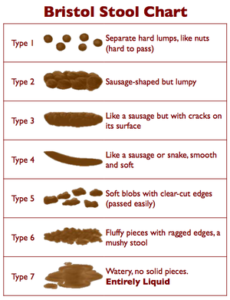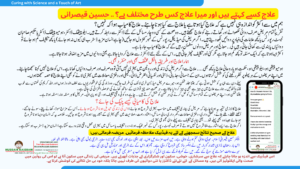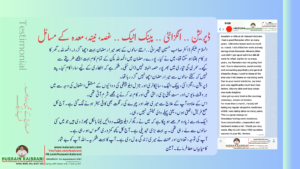Constipation, costiveness, or irregularity, is a condition of the digestive system in which a person (or animal) experiences hard feces that are difficult to expel. This usually happens because the colon absorbs too much water from the food. If the food moves through the gastro-intestinal tract too slowly, the colon may absorb too much water, resulting in feces that are dry and hard. Defecation may be extremely painful, and in severe cases (fecal impaction) lead to symptoms of bowel obstruction. The term obstipation is used for severe constipation that prevents passage of both stools and gas. Causes of constipation may be dietary, hormonal, anatomical, a side effect of medications (e.g. some painkillers), or an illness or disorder. Treatments consist of changes in dietary and exercise habits, the use of laxatives, and other medical interventions depending on the underlying cause.
Signs and symptoms of Constipation

Types 1 and 2 on the Bristol Stool Chart indicate constipation
In common constipation, the stool is hard, difficult, and painful to pass. Usually, there is an infrequent urge to void. Straining to pass stool may cause hemorrhoids and anal fissures, which are painful in themselves. In later stages of constipation, the abdomen may become distended and diffusely tender and crampy, occasionally with enhanced bowel sounds.
The definition of constipation includes the following:[1]
- infrequent bowel movements (typically three times or fewer per week)
- difficulty during defecation (straining during more than 25% of bowel movements or a subjective sensation of hard stools), or
- the sensation of incomplete bowel evacuation.
Severe cases (“fecal impaction”) may feature symptoms of bowel obstruction (vomiting, very tender abdomen) and “paradoxical diarrhea”, where soft stool from the small intestine bypasses the impacted matter in the colon.
Diagnosis for Constipation
The diagnosis is essentially made from the patient’s description of the symptoms. Bowel movements that are difficult to pass, very firm, or made up of small rabbit-like pellets qualify as constipation, even if they occur every day. Other symptoms related to constipation can include bloating, distention, abdominal pain, or a sense of incomplete emptying.[2]
Inquiring about dietary habits may reveal a low intake of dietary fiber or inadequate amounts of fluids. Constipation as a result of poor ambulation or immobility should be considered in the elderly. Constipation may arise as a side effect of medications (especially antidepressants and opiates). Rarely, other symptoms suggestive of hypothyroidism may be elicited.
During physical examination, scybala (manually palpable lumps of stool) may be detected on palpation of the abdomen. Rectal examination gives an impression of the anal sphincter tone and whether the lower rectum contains any feces or not; if so, then suppositories or enemas may be considered. Otherwise, oral medication may be required. Rectal examination also gives information on the consistency of the stool, presence of hemorrhoids, admixture of blood and whether any tumors or abnormalities are present.
X-rays of the abdomen, generally only performed on hospitalized patients or if bowel obstruction is suspected, may reveal impacted fecal matter in the colon, and confirm or rule out other causes of similar symptoms.
Chronic constipation (symptoms present for more than 3 months at least 3 days per month) associated with abdominal discomfort is often diagnosed as irritable bowel syndrome (IBS) when no obvious cause is found. Physicians caring for patients with chronic constipation are advised to rule out obvious causes through normal testing.[3]
Colonic propagating pressure wave sequences (PSs) are responsible for discrete movements of content and are vital for normal defaecation. Deficiencies in PS frequency, amplitude and extent of propagation are all implicated in severe defecatory dysfunction. Mechanisms that can normalise these aberrant motor patterns may help rectify the problem. Recently the novel therapy of sacral nerve stimulation (SNS) has been utilized for the treatment of severe constipation. [4]
Causes of Constipation
The main causes of constipation include:
- Hardening of the feces
- Improper mastication (chewing) of food
- Insufficient intake of dietary fiber
- Dehydration from any cause or inadequate fluid intake
- Medication, e.g. diuretics and those containing iron, calcium, aluminum
- Paralysis or slowed transit, where peristaltic action is diminished or absent, so that feces are not moved along
- Hypothyroidism (underactive thyroid gland)
- Hypokalemia
- Injured anal sphincter (patulous anus)
- Medications, such as loperamide, opioids (e.g. codeine & morphine) and certain tricyclic antidepressants
- Severe illness due to other causes
- Acute porphyria (a rare inherited condition)
- Lead poisoning
- Dyschezia (usually the result of suppressing defecation)
- Constriction, where part of the intestine or rectum is narrowed or blocked, not allowing feces to pass
- Stenosis (Strictures)
- Diverticula
- Tumors, either of the bowel or surrounding tissues
- Obstructed defecation, due to:
- Mechanical causes from morphological abnormalities of the anorectum including megarectum, rectal prolapse, rectocele, and enterocele
- Functional causes from neurological disorders and dysfunction of the pelvic floor muscles or anorectal muscles, including anismus, descending perineum syndrome, and Hirschsprung’s disease
- Retained foreign body or a bezoar
- Psychosomatic constipation, based on anxiety or unfamiliarity with surroundings.
- Functional constipation
- Constipation-predominant irritable bowel syndrome, characterized by a combination of constipation and abdominal discomfort and/or pain[5]
- Smoking cessation (nicotine has a laxative effect)[6]
- Abdominal surgery, other types of surgery, childbirth
Treatment of Constipation
In people without medical problems, the main intervention is to increase the intake of fluids (preferably water) and dietary fiber. The latter may be achieved by consuming more vegetables and fruit and whole meal bread, and pulses such as baked beans and chick peas and by adding linseeds to one’s diet. The routine non-medical use of laxatives is to be discouraged as this may result in bowel action becoming dependent upon their use. Enemas can be used to provide a form of mechanical stimulation. However, enemas are generally useful only for stool in the rectum, not in the intestinal tract.
Lactulose, a non absorbable synthetic sugar that keeps sodium and water inside the intestinal lumen, relieves constipation. It can be used for months together. Among the other safe remedies, fiber supplements, lactitiol, sorbitol, milk of magnesia, lubricants etc. may be of value. Electrolyte imbalance e.g. Hyponatremia may occur in some cases especially in diabetics.
In alternative and traditional medicine, colonic irrigation, enemas, exercise, diet and herbs are used to treat constipation. The mechanism of the herbal, enema, and colonic irrigation treatments often include the breakdown of impacted and hardened fecal matter.
Laxatives
Laxatives may be necessary in people in whom dietary intervention is not effective or is inappropriate. Most laxatives can be safely used long-term, although some are associated with cramping and bloatedness and can cause the phenomenon of melanosis coli.
Physical intervention
Constipation that resists all the above measures requires physical intervention. Manual disimpaction (the physical removal of impacted stool) is done for those patients who have lost control of their bowels secondary to spinal injuries. Manual disimpaction is also used by physicians and nurses to relieve rectal impactions. Finally, manual disimpaction can occasionally be done under sedation or a general anesthetic—this avoids pain and loosens the anal sphincter.
Many of the products are widely available over-the-counter. Enemas and clysters are a remedy occasionally used for hospitalized patients in whom the constipation has proven to be severe, dangerous in other ways, or resistant to laxatives. Sorbitol, glycerin and arachis oil suppositories can be used. Severe cases may require phosphate solutions introduced as enemas.
Homeopathy Treatment for Constipation
Keywords: homeopathy, homeopathic, treatment, cure, remedy, remedies, medicine
Homeopathy treats the person as a whole. It means that homeopathic treatment focuses on the patient as a person, as well as his pathological condition. The homeopathic medicines are selected after a full individualizing examination and case-analysis, which includes the medical history of the patient, physical and mental constitution, family history, presenting symptoms, underlying pathology, possible causative factors etc. A miasmatic tendency (predisposition/susceptibility) is also often taken into account for the treatment of chronic conditions. A homeopathy doctor tries to treat more than just the presenting symptoms. The focus is usually on what caused the disease condition? Why ‘this patient’ is sick ‘this way’. The disease diagnosis is important but in homeopathy, the cause of disease is not just probed to the level of bacteria and viruses. Other factors like mental, emotional and physical stress that could predispose a person to illness are also looked for. No a days, even modern medicine also considers a large number of diseases as psychosomatic. The correct homeopathy remedy tries to correct this disease predisposition. The focus is not on curing the disease but to cure the person who is sick, to restore the health. If a disease pathology is not very advanced, homeopathy remedies do give a hope for cure but even in incurable cases, the quality of life can be greatly improved with homeopathic medicines.
The homeopathic remedies (medicines) given below indicate the therapeutic affinity but this is not a complete and definite guide to the homeopathy treatment of this condition. The symptoms listed against each homeopathic remedy may not be directly related to this disease because in homeopathy general symptoms and constitutional indications are also taken into account for selecting a remedy. To study any of the following remedies in more detail, please visit the Materia Medica section at www.kaisrani.com
None of these medicines should be taken without professional advice and guidance.
Homeopathy Remedies for Constipation :
Acon., aesc., alum., ant-c., apis., bell.,bry., calc., caust., cham., coll., croc., graph., hep., hydr., hydr-ac., kreos., lyc., mag-m., meph., nat-m.,nit-ac., nux-v., nyct., op., paraf., plat., plb., podo., psor., sanic., sep., sil., sulph., verat.
Prevention for Constipation
Constipation is usually easier to prevent than to treat. The relief of constipation with osmotic agents, i.e. lactulose, polyethylene glycol (PEG), or magnesium salts, should immediately be followed with prevention using increased fiber (fruits, vegetables, and grains) and a nightly decreasing dose of osmotic laxative. With continuing narcotic use, for instance, nightly doses of osmotic agents can be given indefinitely (without harm) to cause a daily bowel movement.
Recent controlled studies have questioned the role of physical exercise in the prevention and management of chronic constipation, while exercise is often recommended by published materials on the subject.[7]
In various conditions (such as the use of codeine or morphine), combinations of hydrating (e.g. lactulose or glycols), bulk-forming (e.g. psyllium) and stimulant agents may be necessary to prevent constipation.
Epidemiology
Depending on the definition employed, constipation occurs in 2% of the population; it is more common in women, the elderly and children. [8]
In animals
Hibernating animals can experience tappens that are usually expelled in the spring. For example, bears eat many foods that create a “rectal plug” before hibernation.
Canines may also experience constipation, which they usually attempt to rectify by ingesting grass and other plant materials.
References
- ^ Emedicine, “constipation”.
- ^ MedicineNet
- ^ Longstreth GF, Thompson WG, Chey WD, Houghton LA, Mearin F, Spiller RC (2006). “Functional bowel disorders”. Gastroenterology 130 (5): 1480–91. doi:10.1053/j.gastro.2005.11.061. PMID 16678561.
- ^ Philip G. Dinning (2007). “Colonic manometry and sacral nerve stimulation in patients with severe constipation”. Pelviperineology 26 (3): 114–116. [1]
- ^ Caldarella MP, Milano A, Laterza F, et al (2005). “Visceral sensitivity and symptoms in patients with constipation- or diarrhea-predominant irritable bowel syndrome (IBS): effect of a low-fat intraduodenal infusion”. Am. J. Gastroenterol. 100 (2): 383–9. doi:10.1111/j.1572-0241.2005.40100.x. PMID 15667496.
- ^ “Nicotine withdrawal symptoms:Constipation“. helpwithsmoking.com (2005). Retrieved on 2007-06-29.
- ^ MESHKINPOUR H. ; SELOD S. ; MOVAHEDI H. ; NAMI N. ; JAMES N. ; WILSON A. ; (1998). “Effects of regular exercise in management of chronic idiopathic constipation”. Digestive diseases and sciences 43 (11): 2379-2383. ISSN 0163-2116.
- ^ Sonnenberg A, Koch TR (1989). “Epidemiology of constipation in the United States”. Dis. Colon Rectum 32 (1): 1–8. doi:10.1007/BF02554713. PMID 2910654.
Related posts:
- Anal fissure – Homeopathy Treatment and Homeopathic Remedies
- Venous thrombosis – Homeopathy Treatment and Homeopathic Remedies
- Stomach cancer – Homeopathy Treatment and Homeopathic Remedies
- Teething – Homeopathy Treatment and Homeopathic Remedies
- Laryngitis – Homeopathy Treatment and Homeopathic Remedies





